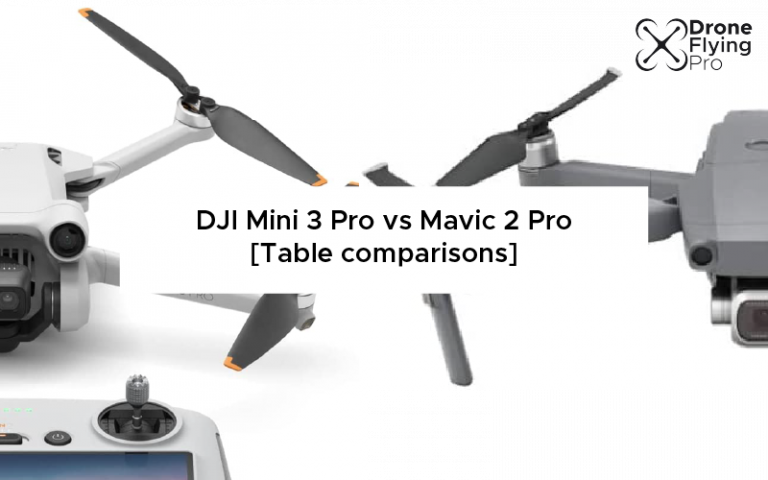DJI is, arguably, the best company currently producing consumer-level drones. Recently they released the DJI Mavic 3 Pro, and you may be wondering what the main differences are between this drone and other popular DJI drones. In this article, I will discuss the differences between the DJI mini 3 Pro and Mavic 2 Pro. The drone flying community and hobby flyers have received these very popular models well received.
The DJI Mini 3 Pro is the best option if you want a small, affordable drone with long flight times and portrait photos and videos. The DJI Mavic 2 Pro has a slight advantage with Gimbal controllable range and upwards obstacle sensing.
Here is a quick decision graphic if you are looking for a summary of the main pros of each drone.
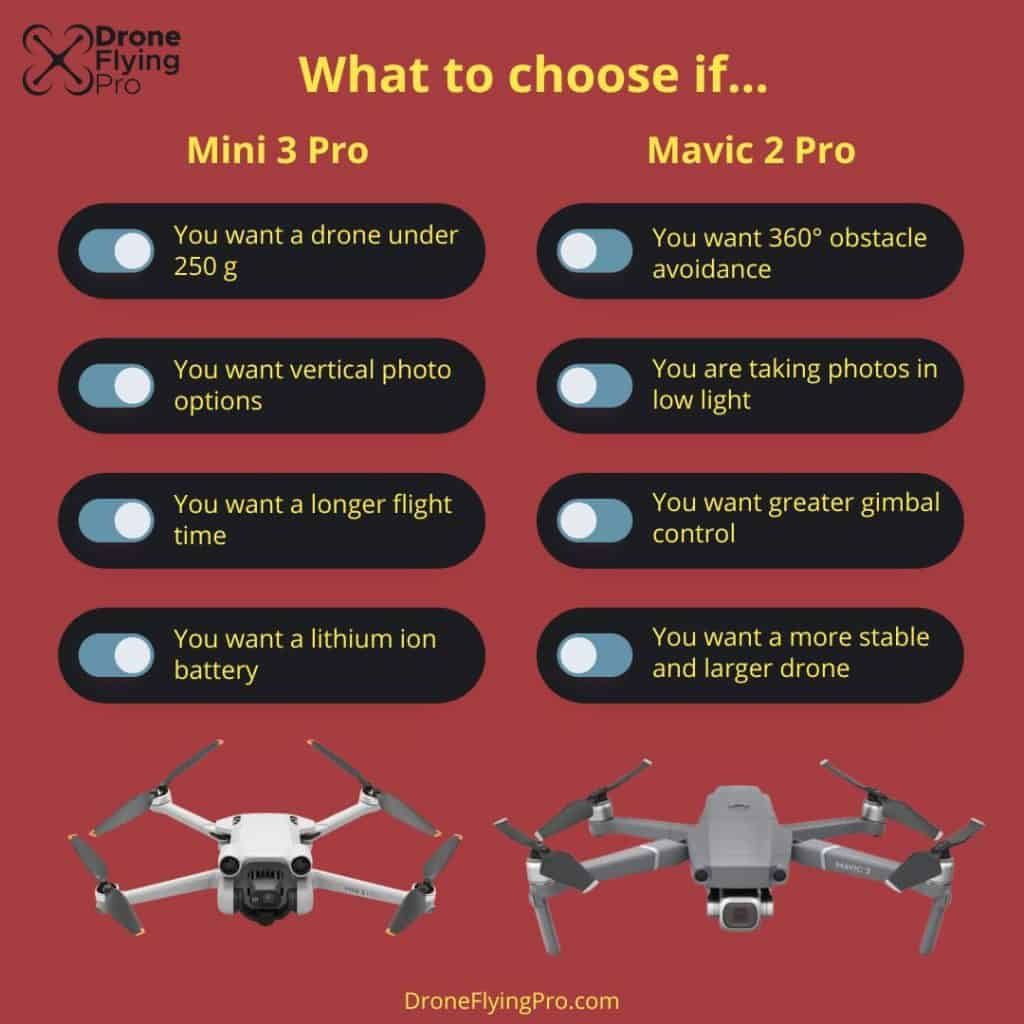
the DJI mini 3 Pro is packed with an incredible amount of technology in a very small form factor. It brings all of the larger drones’ best aspects, such as obstacle sensing and high-resolution video, in a very small 249 g package.
The DJI mini 3 Pro camera can also turn vertically to capture mobile first images.
The Mavic 2 Pro is a fantastic older drone with a maximum flight time of 31 minutes and a Hasselblad camera. The professional camera means you can capture gorgeous 20-megapixel aerial shots in stunning colour detail. It stands up to the modern and more recent drones very well.
Here is everything you need to know about comparing the DJI mini 3 Pro versus Mavic 2 Pro. I have tabulated each important specification against each others.
Aircraft comparison
The drone’s physical size and performance are crucial when deciding on the best drone for you. If you want a smaller drone to get around some of the red tape associated with flying drones at less than 250 g, the Mini 3 Pro is certainly the best option.
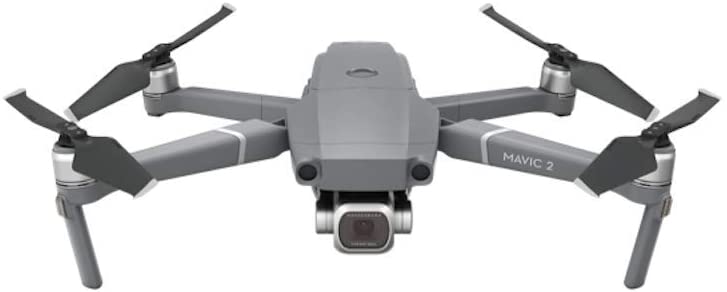
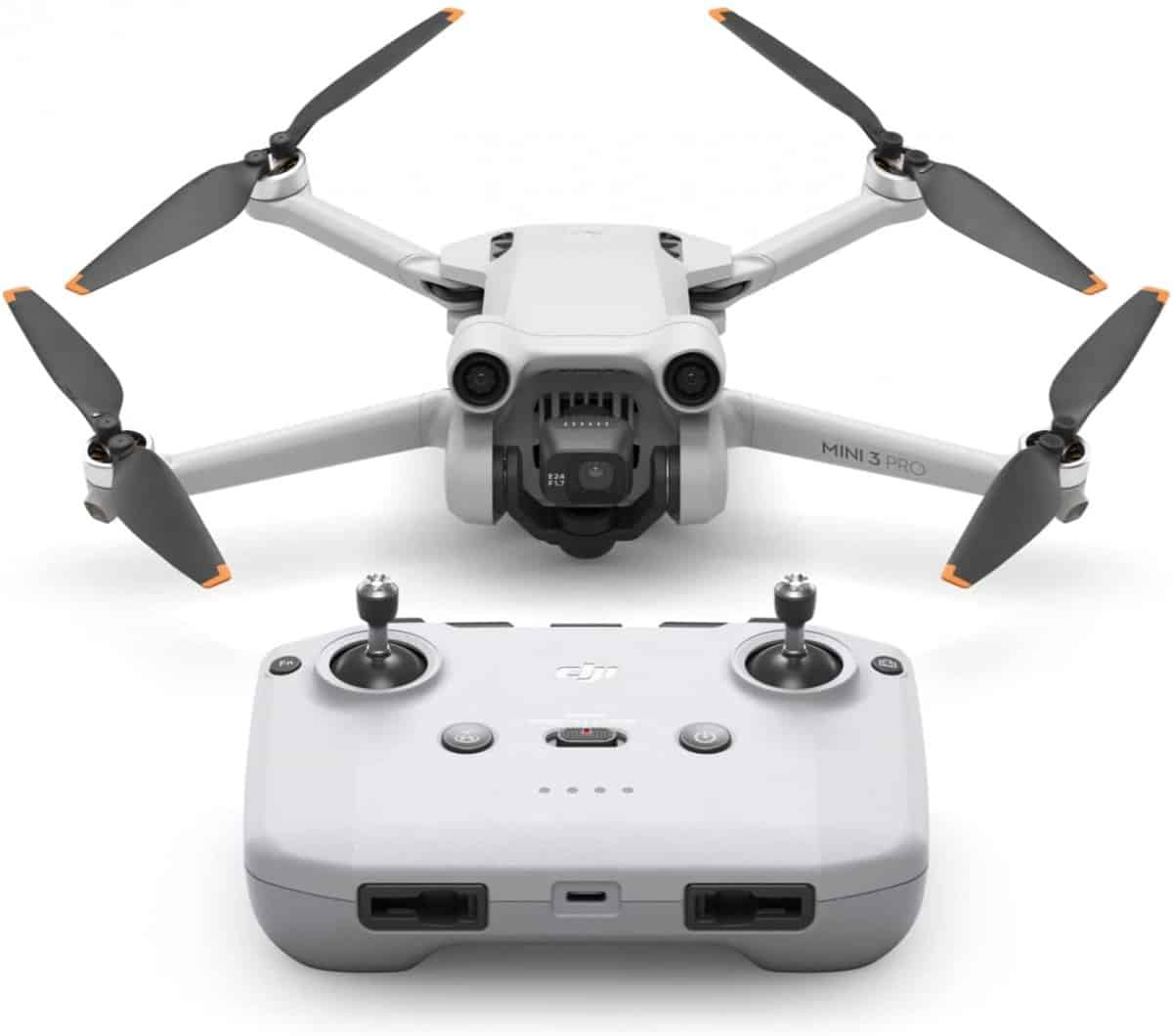
However, with a much larger drone, you get stronger motors and a higher speed.
| Spec | Mini Pro 3 | Mavic 2 Pro | TLDR |
| Take off weight | < 249 g | 907 g | The mini Pro 3 is much lighter |
| Dimensions | Folded: 145×90×62 mm Unfolded: 171×245×62 mm Unfolded (with propellers): 251×362×70 mm | Folded: 214×91×84 mm (length×width×height) Unfolded: 322×242×84 mm (length×width×height) | The mini 3 Pro is much smaller |
| Max Flight Time (no wind) | 34 mins (with Intelligent Flight Battery and measured while flying at 21.6 kph in windless conditions) 47 mins (with Intelligent Flight Battery Plus | 31 minutes (at a consistent 25 kph) | The mini Pro 3 has a better maximum flight time |
| Max Hovering Time (no wind) | 30 mins (with Intelligent Flight Battery) 40 mins (with Intelligent Flight Battery Plus) | 29 minutes | The mini Pro 3 is 10 minutes longer flight with intelligent flight battery |
| Max Flight Distance (no wind) | 18 km (with Intelligent Flight Battery) 25 km (with Intelligent Flight Battery Plus) | 18 km (at a consistent 50 kph) | The same |
| Max Flight Speed (near sea level, no wind) | 16 m/s (S Mode) 10 m/s (N Mode) 6 m/s (C Mode) | 20 kph (S-mode) | Higher speed with the Mavic 2 Pro |
| Max Wind Speed Resistance | 10.7 m/s | 10.6 m/s | Equal |
The mini 3 Pro can have much larger flying times because it weighs significantly less, and the batteries are lighter and can carry a significant amount of charge. However, if you want a faster drone and a more stable drone in the air, the Mavic 2 Pro is a better option.
A larger drone will result in more stable flying in windy conditions. The extra stability comes from the extra weight and motor power.
Camera
Many buy a drone to take advantage of the unique aerial vantage point to capture aerial photos and video.
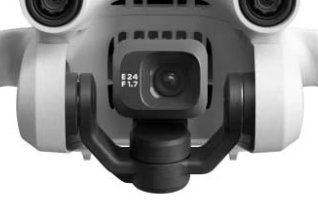

You cannot hot swap the cameras of these drones; therefore, the hardware that gets carried is very important.
Here is every important feature of the camera compared.
| Spec | Mini 3 Pro | Mavic 2 Pro | TLDR |
| Sensor | 1/1.3-inch CMOS Effective Pixels: 48 MP | 1″ CMOS Effective Pixels: 20 million | Mavic 2 Pro is bigger |
| Lens | FOV: 82.1° Format Equivalent: 24 mm Aperture: f/1.7 Focus Range: 1 m to ∞ | FOV: about 77° 35 mm Format Equivalent: 28 mm Aperture: f/2.8–f/11 Shooting Range: 1 m to ∞ | Larger aperture range with the Mavic 2 Pro. |
| ISO Range | Video: 100-6400 (Auto), 100-6400 (Manual) Photo: 100-6400 (Auto), 100-6400 (Manual) | Video: 100-6400 Photo: 100-3200 (auto) 100-12800 (manual) | Larger iso range with the Mavic 2 Pro |
| Still Image Size | 4:3: 8064×6048 (48 MP), 4032×3024 (12 MP) 16:9: 4032×2268 (12 MP) | 5472×3648 | More options with the mini 3 Pro |
| Video Resolution | 4K: 3840×2160@24/25/30/48/50/60fps 2.7K: 2720×1530@24/25/30/48/50/60fps FHD: 1920×1080@24/25/30/48/50/60fps Slow Motion: 1920×1080@120fps | 4K: 3840×2160 24/25/30p 2.7K: 2688×1512 24/25/30/48/50/60p FHD: 1920×1080 24/25/30/48/50/60/120p | More frame rate options with the mini 3 Pro in 4K |
| Digital Zoom | 4K: 2x 2.7K: 3x FHD: 4x | None | Digital Zoom only available in the newer drone |
In terms of the camera, the newer drone (mini 3 Pro) wins in almost every regard. However, if you are doing a lot of low-light photography, the increased manual iso range of the Mavic 2 Pro may be better for you.
There are a few more options with the older Mavic 2 Pro drone camera settings. However, the digital Zoom is very impressive in the newer mini 3 Pro.
Gimbal
Ensuring that the Gimbal has 3-a stabilization xis and can handle a lot of instability during the flight means that the photos and videos will be good for professional use. There’s nothing worse than pushing the capture button and receiving a blurry video or photo.
Here is everything you need to know about the two gimbals of the mini 3 Pro versus the Mavic 2 Pro
| Spec | Mini 3 Pro | Mavic 2 Pro | TLDR |
| Stabilization | 3-axis mechanical gimbal (tilt, roll, and pan) | 3-axis (tilt, roll, pan) | Equal |
| Mechanical Range | Tilt: -135° to 80° Roll: -135° to 45° Pan: -30° to 30° | Tilt: -135–45° Pan: -100–100° | The mechanical range is better in the pan range in the Mavic 2 Pro |
| Max Controllable Speed (tilt) | 100°/s | 120° /s | Faster maximum speed in the Mavic 2 Pro |
| Controllable Range | Tilt: -90° to 60° Roll: -90° or 0° | Tilt: -90–30° Pan: -75–75° | Mini 3 Pro is better for vertical video, and the Mavic 2 Pro is better for panning shots |
The biggest difference in these drones in terms of the Gimbal is that you can tilt the full camera to portrait mode in the Mini 3 Pro. This aspect is perfect if a lot of your content is on social media and consumed by people on their mobile phones.
On the other hand, the Mavic 2 Pro has a -75 to 75° pan controllable range, which is not available on the mini 3 Pro. Framing your standard (non-vertical) shots would be much easier with the Mavic 2 Pro.
Sensors
Keeping your drone as safe as possible during its flight is very important, and that is why you need to look at the sensing system that comes with a drone. I have flown my drone in various conditions, and the sensing system has saved me multiple times from colliding with trees, buildings, and people.
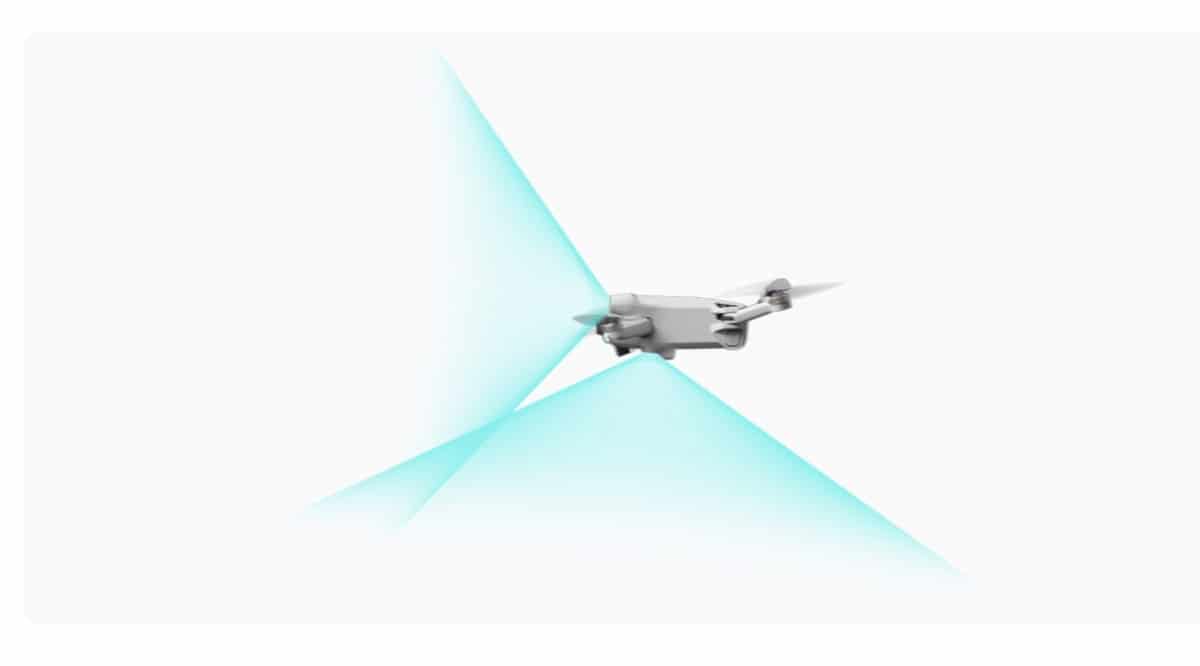
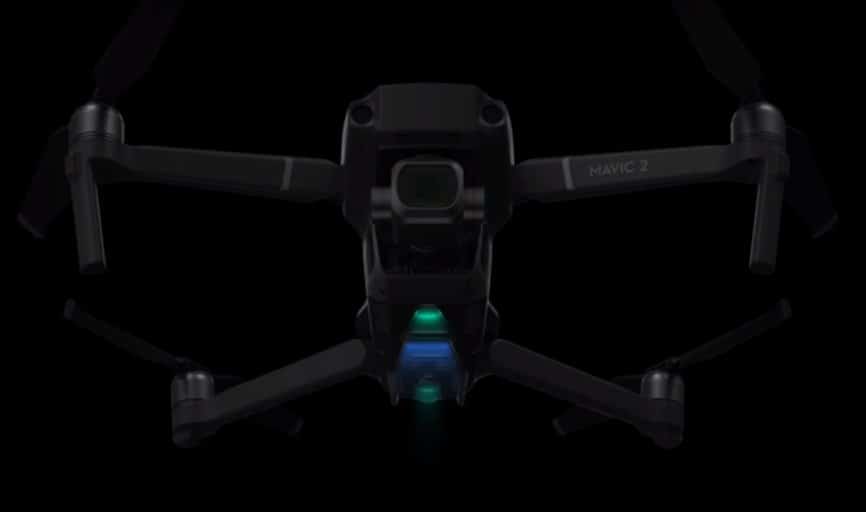
While you are busy looking down at the screen, you can sometimes forget that the drone is in a 3D environment, and the sensing system will give you an extra piece of mind and stop you from hitting overhanging branches or obstacles.
| Spec | Mini Pro 3 | Mavic 2 Pro | TLDR |
| Forward | Precision Measurement Range: 0.39-25 m Effective Sensing Speed: Flight speed <10 m/s FOV: Horizontal 106°, Vertical 90° | Precision Measurement Range: 0.5 – 20 m Detectable Range: 20 – 40 m Effective Sensing Speed: ≤ 14m/s FOV: Horizontal: 40°, Vertical: 70° | Both will keep you safe |
| Backward | Precision Measurement Range: 0.36-23.4 m Effective Sensing Speed: Flight speed <10 m/s FOV: Horizontal 58°, Vertical 73° | Precision Measurement Range: 0.5 – 16 m Detectable Range: 16 – 32 m Effective Sensing Speed: ≤ 12m/s FOV: Horizontal: 60°, Vertical: 77° | Both will keep you safe |
| Downward | Precision Measurement Range: 0.15-9 m Precise Hovering Range: 0.5-12 m Vision Sensor Hovering Range: 0.5-30 m Effective Sensing Speed: Flight speed <3 m/s FOV: Forward/Backward 104.8°, Left/Right 87.6° | Precision Measurement Range: 0.5 – 11 m Detectable Range: 11 – 22 m | Both will keep you safe |
| Upward | None | Precision Measurement Range: 0.1 – 8 m | Upwards available in the Mavic 2 Pro |
Ultimately, the two drones will be very safe. However, if you are performing shots in many areas with overhanging obstacles that you will be getting under, the upward obstacle avoidance the DJI Mavic 2 Pro will be a better fit for your needs.
Battery
Drones achieve longer and longer flight times due to their advanced battery systems. DJI has continued to push the limits of what is capable and possible for consumer-level drones with the DJI Mini 3 Pro. It has a fantastic lifespan and even the regular intelligent battery is much more capable than previous versions of the mini.
| Spec | Mini 3 Pro | Mavic 2 Pro | TLDR |
| Capacity | 2453 mAh (3850 mAh) | 3850 mAh | Larger capacity found in the Mavic 2 Pro |
| Battery Type | Li-ion | LiPo 4S | Lithium polymer battery requires much more rigourous maintenance |
| Weight | 80.5 g | 297 g | Mavic 3 Pro battery is lighter. |
Both batteries are more than capable of powering your drone efficiently and safely. However, the older technology in the Mavic 2 Pro is lithium polymer which requires more rigorous maintenance than a lithium-ion battery. I have not had any issue with my original DJI Mavic air over many years with a lithium polymer battery. Still, if you regularly expose your drone to hot temperatures, it may be worth avoiding this technology and opting for the newer drone.
Summary
Both drones are powerhouses, but the newer DJI Mini 3 Pro offers a lot more technology and capability packed into a smaller form factor.
If you are a professional photographer and need extra controllable range in your gimbal and take photographs in a lowlight setting that requires a much higher iso setting, you may find that the Mavic 2 Pro is a better fit for your use case.
